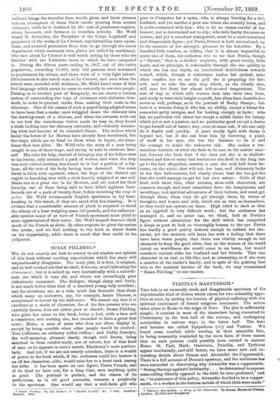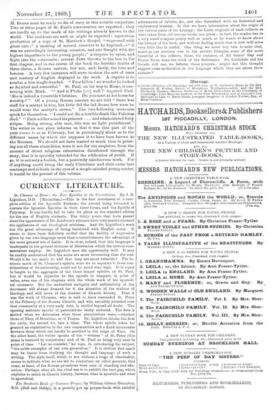VESTINA'S MARTYRDOM.* This tale is an unusually crude and disagreeable
specimen of the objectionable kind of fiction which caters for two unhealthy appe- tites at once, by mixing the horrors of physical suffering with the spiritual excitement of forced religious sentiment. The action takes place at Rome in the reign of Nero. The plot is sufficiently simple ; it consists in most of the characters being converted to Christianity in the first half of the volume, and undergoing martyrdom in various ways in the latter half. The hero and heroine are called Epipodious (sic) and Vestina. We found some comfort while reading of their miserable fate, in being constantly reminded by the mere form of these names that no such persons could possibly have existed in ancient Rome. St. Paul, Mark, Onesimus, Priscilla, and Tychicus appear incidentally, and still better, we have some new and in- teresting details about Demas and Alexander the Coppersmith. There is a full account of Demas's apostacy, and the authoress has even succeeded in discovering why Alexander was a coppersmith. "Seeing the rage against Christianity. . . he determined to espouse some calling directly opposed to the faith he once professed," and so, "in pursuance of this policy, Alexander decided to be a copper- smith, or a worker in the various metals of which idols were made."
• Trraincia Martyrdom: a Story of the Catacombs. By Emma Raymond Mum. London ; Hodder and Stoughton. M. Renan must be ready to die of envy at this notable conjecture. Two or three pages of St. Paul's conversation are reported ; they are hardly up to the mark of his writings already known to the world. The incidents are such as might be expected ; mysterious production of a copy of St. Matthew's Gospel, "engrossed with great care ;" a meeting of several converts to be baptized,—" it was an exceedingly interesting occasion, and one fraught with the highest importance to the young people ;" a surprise by spies, and flight into the catacombs ; several Jews thrown to the lion in the first chapter, and in the course of the book the horrible deaths of three slaves, a Roman matron, her son, and, lastly, the hero and heroine. A very few instances will serve to show the sort of taste and mastery of English displayed in the work. A captive is to combat a lion single-handed. "Poor fellow ! no wonder he looked so dejected and sorrowful." St. Paul, on his way to Rome, is con- versing with Mark. " ' And is Phebe [sic] well ?' inquired Paul. 'She is indeed a venerable Christian. Do you meet at her house for worship?" Of a young Roman convert we are told "there was stuff for a martyr in him, but little did the lad dream how soon he would wear the martyr's crown." The two following sentences speak for themselves. "1 could not dies terrible death like Felicitas died." "Each soldier seized his prisoner. . . and administered forty stripes. Being strong, able men, this was no light punishment." The writer in one place informs us that it was that part of the year known to us as February, but is provokingly silent as to the different name by which she supposes it to have been known to the Romans. We should not have wasted so much time in point- ing out all these absurdities, were it not for our suspicion, from the amount of direct religious exhortation distributed through the story, that it is specially intended for the edification of youth. If so, it is not only a foolish, but a positively mischievous work. For if anything could bring the early Christians and their cause into contempt and ridicule in the eyes of a simple-minded young reader, it would be the perusal of this volume.



































 Previous page
Previous page